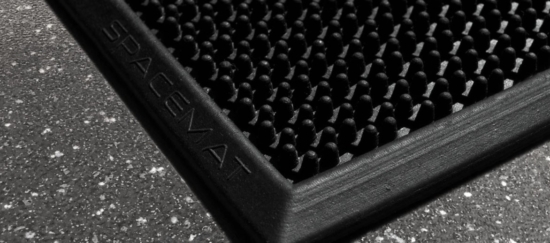Recycled tyres + graphene = SpaceMat
 SpaceBlue aim to create a range of tyre-derived, graphene-enhanecd home furnishings (Photo: SpaceMat)
SpaceBlue aim to create a range of tyre-derived, graphene-enhanecd home furnishings (Photo: SpaceMat)
As we have all witnessed during the last 12 months, the recycled tyre business is experiencing something of a renaissance at the moment. And the abilities of wondering molecule graphene are well-documented. But what happened when you combine the two? The answer, according to one Greater Manchester-based startup is SpaceMat.
SpaceMat launched the first of a range of products aimed at reducing wastage from vehicle tyres in the Autumn of 2020, supported by the Graphene Engineering Innovation Centre’s (GEIC) ERDF Bridging the Gap programme at The University of Manchester.
In conjunction with the GEIC, Dr Koncherry Koncherry developed SpaceMat – a flooring product that uses graphene to improve the performance of recycled tyre rubber compared to previous efforts.
It’s estimated that 1.5 billion waste tyres are generated globally every year and most end up in landfill or being burned. Numerous attempts have been made to produce high-quality recycled rubber from tyres, but the shedding of microparticles from resultant products has raised concerns over environmental health. Dr Vivek’s company Space Blue has successfully developed graphene-enhanced recycled rubber products for mass-market applications that address this issue.
According to the company, the SpaceMat product is constructed from 80 per cent waste tyre material and 20 per cent graphene-enhanced natural rubber. The graphene more than doubles the compressive strength of the rubber, in turn increasing the durability of the mat. Using graphene, it is possible to engineer the mechanical performance of the recycled material, bringing it close to the performance of a virgin polymer system.
James Baker, CEO Graphene@Manchester, said: “Our Bridging the Gap programme specifically targets Greater Manchester-based SMEs and has been a great opportunity to support local innovation. It’s really exciting to see this new company entering into the market, in particular with its focus on supporting environmental sustainability and a good re-use of scrap tyres, which otherwise could cause significant pollution and waste product.”
Innovation in the area of sustainability is one of the criteria governing research activities at GEIC and is also vital in securing funding from the Bridging the Gap programme.
Bridging the Gap aims to help SMEs like Dr Koncherry’s make the transition from original idea to market-ready product. Paul Wiper, Application Manager for Bridging the Gap at the GEIC, said: “This is exactly the type of enterprise and concept our BtG programme aims to address. We offer technical input and R&D programmes to Greater Manchester start-ups and existing companies to accelerate graphene-based products and processes.”
Having launched SpaceMat, Dr Koncherry is now developing a range of other products including traffic cones and anti-viral doormats and is looking for partners to licence and promote the technology globally:
“SpaceBlue is on a mission to solve the global problem of waste tyre using graphene by developing sustainable and circular economy products. Thanks to colleagues at the GEIC and funding from Bridging the Gap, we’re making real progress towards achieving that goal.”



Comments